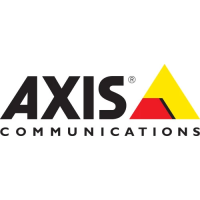
Do you have a question about the Axis P1343 and is the answer not in the manual?
| Connectivity Technology | Wired |
|---|---|
| Sensor Type | CMOS |
| Frame Rate | 30 fps |
| Minimum Illumination | 0.5 Lux |
| Compression | H.264, MJPEG |
| Network Interface | 10/100 Ethernet |
| Ethernet Ports | 1 |
| Power Supply | 12 V DC |
| Power over Ethernet (PoE) | Yes |
| Day/Night | Yes |
| IR Sensitivity | No |
| Humidity | 20% to 80% (non-condensing) |
| Ingress Protection | IP66 |
| Features | Motion Detection |
| Protocols | IPv4, IPv6, HTTP, HTTPS, RTSP, RTP, TCP, UDP, DHCP, DNS |
| Operating Conditions | -10 °C to 50 °C (14 °F to 122 °F) |
| Lens Type | Vari-focal lens |
Legal disclaimer regarding manual accuracy and product responsibility.
Information on Axis' patents and software licenses.
Guidelines for modifying the camera and regulatory compliance.
List of registered trademarks used in the document.
Contact information and resources for technical assistance.
Overview of the main capabilities and advantages of the network cameras.
Steps to access the camera's interface via a web browser.
Instructions for accessing the camera over the internet.
Procedure for setting the administrator password for initial access.
Description of common controls on the Live View page.
Explanation of the AMC toolbar buttons for video playback and control.
Details on controlling audio input and output via AMC.
How to use digital PTZ features like joystick and preset positions.
Navigation to camera configuration menus and their purpose.
Explanation of H.264 compression and streaming protocols.
Details on using Motion JPEG for video streams.
Using AMC for video access and configuration.
Methods for accessing video streams besides AMC.
Options for accessing audio streams from the camera.
Settings for resolution, compression, and frame rate.
Adjusting image quality parameters like brightness and contrast.
Configuring text, date, and time overlays on the video feed.
Enabling and configuring audio in video streams.
Details on bit rate control and frame size for H.264/MJPEG.
Creating and managing pre-programmed video stream configurations.
Fine-tuning image quality like color, brightness, and sharpness.
Adjusting colors for different lighting conditions.
Improving exposure in high contrast scenes.
Configuring exposure for optimal image quality and frame rate.
Adding static images or logos to the video stream.
Configuring areas to obscure in the video feed.
Tools and steps for achieving optimal focus.
Setting up audio modes like full, half, and simplex duplex.
Connecting microphones or line sources and setting input gain.
Configuring the arrangement of elements on the Live View page.
Choosing pre-programmed or custom video stream profiles.
Selecting preferred methods for viewing video streams.
Configuring the viewer toolbar and PTZ joystick mode.
Enabling and configuring buttons for events and outputs.
Creating custom links for quick access to URLs or scripts.
Setting up servers for receiving uploaded event images and notifications.
Defining triggers and actions for various events.
Setting up events triggered by inputs, motion, or tampering.
Configuring actions to save streams upon event triggers.
Configuring events to occur at specific times or intervals.
Setting up alarms for physical interference with the camera.
Using motion detection to generate alarms based on movement.
Setting up include and exclude windows for motion detection.
Enabling and configuring digital PTZ features.
Saving and recalling specific camera views.
Setting up automated camera movement sequences.
Enabling or disabling specific PTZ controls.
Managing user accounts and access privileges.
Configuring password, IP filtering, HTTPS, and 802.1X.
Using certificates for secure web browsing.
Setting up network access control using 802.1X.
Setting the camera's date, time, and time zone.
Configuring IP address, subnet mask, and gateway.
Details on obtaining IP addresses via DHCP or static assignment.
Setting up DNS servers for name resolution.
Configuring the network time protocol server.
Assigning a host name for network access.
Using a Link-Local IP address for UPnP.
Configuring the router for remote access via NAT.
Enabling and configuring the FTP server for firmware uploads.
Enabling and configuring the Real-Time Streaming Protocol.
Using a SOCKS server for network access through firewalls.
Configuring network traffic prioritization.
Configuring SNMP traps for event notifications.
Enabling secure SNMP v3 for network management.
Network discovery protocols for automatic device detection.
Setting up and managing the SD card for local recording.
Connecting external devices via input/output ports.
Understanding the status lights on the camera.
Restarting, restoring defaults, and accessing support resources.
Accessing system and access logs for troubleshooting.
Creating server reports and parameter lists for support.
Finding basic information and third-party software licenses.
Procedures for restoring the camera to its original settings.
Details on RJ-45 Ethernet and 2-pin power terminal blocks.
Information on connecting microphones and speakers.
Using the SD card slot for local recording.
Verifying the current firmware for problem resolution.
Steps for updating the camera's software.
Resolving issues with setting and accessing the IP address.
Troubleshooting external access and firewall issues.
Resolving problems with H.264 video display and quality.
Diagnosing and resolving low frame rates.
Addressing issues like dark images, missing uploads, or slow updates.
Troubleshooting focus problems and display mask issues.
Resolving issues with audio input and output.
Troubleshooting problems with SD card recording and mounting.
Details on image sensor, lens, and day/night functionality.
Information on resolutions, frame rates, and video streaming.
Specifications for audio compression, input/output, and network protocols.
Details on API, intelligent video, and alarm events.
Information on installation, casing, processors, and power.
Specs for connectors, local storage, operating conditions, and approvals.
Details on image sensor, lens, resolutions, and frame rates.
Specifications for PTZ, user limits, and audio compression.
Details on password protection, IP filtering, and encryption.
Information on API, intelligent video, and alarm events.